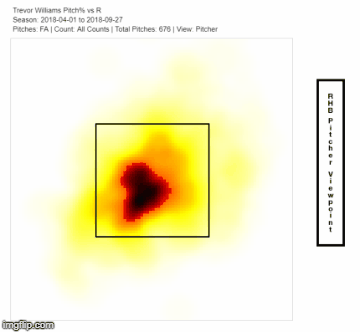This May Not Be Last Season’s Trevor Williams
Trevor Williams ranked 32nd in Roto value for standard 12-team mixed leagues last season. Yet the Pirates’ righty typically went undrafted in those formats this year (292 FantasyPros ADP), and it’s not hard to figure out why. Williams was below average as a strikeout pitcher (18.0 percent K-rate) and didn’t stand out as a control pitcher or inducer of chases or ground balls. His .261 BABIP and 76.6 percent strand rate were just favorable enough to make owners suspicious.
I liked the 2018 version of Williams. I drafted him in my 12-team Head-to-Head points league and wish I had picked him up in a few more places. Last season, there were three pitchers who allowed at least 500 batted balls, averaged less than 91 mph on exit velocity on flyballs and line drives and averaged less than 83 mph on exit velocity on ground balls. They were Williams, Zack Wheeler and Miles Mikolas. In research I conducted this offseason with Alex Chamberlain, we learned that EV FB/LD has been positively correlated with HR/FB over the last four seasons and EV GB has positively correlated with BABIP. Both EV measurements have also had statistically significant (p < .05) year-to-year correlations.
Though I had anticipated some BABIP and LOB% regression this season, I still ranked Williams 91st among starting pitchers in my preseason rankings (based on projected Roto value). Of the five RotoGraphs analysts who published rankings on FantasyPros, I had him ranked the highest.
My optimism over Williams had nothing to do with any expected improvement as a strikeout pitcher this season and everything to do with his demonstrated ability to limit hard contact. (He was also above average in this regard on flies and liners in 2017 and had one of the lowest EV GB averages on grounders that year.) Now Williams is giving us a reason to hope that he might be one of the majors’ great smotherers of hard contact and a misser of bats.
The early-season small sample disclaimer very much applies here. Williams has made two starts to date, having thrown 167 pitches and yielded 36 batted balls. His performance to date could prove to be a blip on the radar that would have gone barely noticed if it happened in mid-June. It could also be the beginning of something new, so that makes him a must-add to your watch list, if not to your roster.
In each of his first two starts, Williams has exceeded a 10 percent SwStr%, and his overall rate of 11.4 percent is 3.5 percentage points above his mark from last season. His Z-Swing% has risen by nearly 10 points, and his Z-Contact rate is down by almost nine points. The major league norm for O-Swing% so far is 29.3 percent, but Williams has posted marks of 37.5 and 44.7 percent in his first two starts, both of which have come against the Reds.
We may need to take those chase rates with some extra grains of salt, since the Reds have been the majors’ least disciplined offense so far. Then again, their collective O-Swing% of 34.7 percent is still well below the rates they posted in each of Williams’starts. It’s not as if Williams had shown a proclivity for being great at inducing chases before, given his career 30.5 percent rate. The Reds have been only a little worse than the typical team at making contact on pitches in the zone (82.9 percent Z-Contact%), so Williams’ plunging Z-Contact% rate just might be of his own doing.
Maybe, then, there really is something different about Williams this year. From looking at his 19.6 percent strikeout rate, that may not be obvious, but if he continues to get swinging strikes at a dramatically higher rate, that mark should rise (even if his called strike rate doesn’t budge). Williams has thrown his four-seamer the most frequently of all his pitches by far, so that would be the first place to look for change. And change is what we find. Though Williams is not (yet) throwing the pitch harder, he is getting more movement on it. That could be playing a role in the substantial increases in both his swing and whiff rates.
| Year | Pitches | Avg. Velo | xMov | zMov | O-Swing% | Z-Swing% | Z-Contact% | SwStr% |
|---|---|---|---|---|---|---|---|---|
| 2018 | 1399 | 91.2 | -2.5 | 7.2 | 23.3% | 62.4% | 88.1% | 7.0% |
| 2019 | 90 | 91.7 | -3.5 | 7.7 | 38.5% | 74.5% | 73.7% | 15.6% |
Williams has also been varying his four-seamer location more against right-handed batters, and he is avoiding the heart of the strike zone a little more often than he did last season.

Even if you, like me, have not been prone to write a pitcher off just because of a heavy reliance on avoiding hard contact, it’s hard to ignore the increase in value that is likely to come if a pitcher gets better at avoiding contact altogether. Williams has now done that in a pair of starts against the Reds. We won’t get a chance to see if he can extend this trend into a third start until Friday, when the Pirates begin a three-game series at Nationals Park. It should be a good test of whether he has truly gotten better at inducing swings. The Nationals have the majors’ seventh-lowest O-Swing% and the fifth-lowest Z-Swing%.
Al Melchior has been writing about Fantasy baseball and sim games since 2000, and his work has appeared at CBSSports.com, BaseballHQ, Ron Shandler's Baseball Forecaster and FanRagSports. He has also participated in Tout Wars' mixed auction league since 2013. You can follow Al on Twitter @almelchiorbb and find more of his work at almelchior.com.